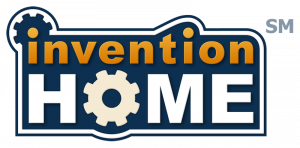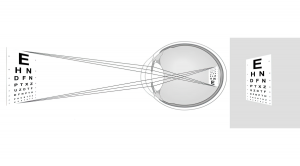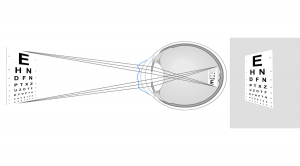InventionHome® Inventor Creates Corrective Lens and 3D Printing Method to Help Correct Vision Distortion due to Warping
The retina is scanned and mapped using Ocular Coherence Tomography (OCT) or other topographical measuring devices like A-scan (Amplitude Scan), OptoMap, Fluorescein Angiography, or other fine three-dimensional measuring tools. The lens could one day be inserted as a replacement lens to the patient’s biologically native lens, and could be correctable over time if necessary; however, that technology is still in development, and scientists are attempting to pursue a solution. One scientist has attempted to make a pair of glasses, but as soon as the patient’s eye went off axis with the lens, the warp worsened. Currently, the best solution is the scleral lens which has its first layer made from a mold of the cornea, allowing it to fit to the eye and stay on axis. The freeform unWarp portion would be a second layer, and the third layer would be an overall prescription, if necessary, or a smooth layer for blinking.
The lens may be 3D printed polymer, created from a 3D printed mold from other lens materials, or through other three-dimensional processes. This lens may also be made conventionally, but with potentially less accuracy. By 3D printing, the lens can pick up more corrective details derived from a map of the retinal surface inverted and reversed into free-form optics also called a wobbly lens, where, for example, convex bumps in the retina may become corrected by concave parts of the lens where it translates best to reverse the warped signal to the brain caused by the uneven, damaged retina.
Several eye diseases can cause eye warp like macular degeneration, diabetes, hypertension, epiretinal membrane, and others. Warped vision makes it nearly impossible to focus on objects and items for long periods of time. The brain tries to control eye and facial muscles to compensate and maintain focus; however, this leads to massive headaches which are incredibly uncomfortable. People with warped vision can read lines of text but cannot see, draw, or focus on straight lines—thereby rendering faces to look more like Picasso paintings than human, a heartbreaking experience.
The inventor of unWarp, Dave, has two warped retinas due to epiretinal membrane contraction causing puckering of the retinas. Dave pioneered a successful 30-year career as a visual effects artist, known for feature films such as Moanna, The Matrix Reloaded, Life of Pi, and many more; however, he first noticed an anomaly with his vision while working on the new Batman movie and thought it was an issue with the prescription contact lenses he was wearing. The issue turned out to be organic, despite feeling simply optical.
After four eye surgeries to hopefully arrest the fast-moving condition, Dave was forced into an early, heartbreaking retirement after a long and rewarding career in the industry due to the strain this condition put on his eyes when trying to focus on creating art. The subjective perspective of feeling like the condition was optical led him to believe an optical fix could be available, and he began interviewing optical physicists, ophthalmologists, optometrists, and scleral lens manufacturers, He originally had InventionHome do a patent search with the intent on finding who could help him and volunteer to be a test subject, but no one was working on it, so he asked the company to assist him with a patent for unWarp and help him find partners in the optics industry.
While there is no current cure for eye diseases like macular degeneration, several treatment methods are currently available. Epiretinal peal (which is what Dave has had done on both eyes), anti-VEGF injections, photodynamic therapy (PDT), laser therapy, and low vision aids can all contribute to helping people with warping make the most of their remaining vision. These treatments only focus on managing the symptoms and slowing down the progression of diseases. The unWarp lens and method ultimately aim to work toward alleviating distorted vision issues and deserve significant examination by the healthcare industry and manufacturers in this field.
David filed his Utility Patent with the United States Patent and Trademark Office (USPTO) and is working closely with InventionHome, a leading invention licensing firm, to sell or license the patent rights to his unWarp product. Ideal licensing candidates would be U.S. based product manufacturers or distributors looking to further develop and distribute this product innovation.
Companies interested in unWarp can contact InventionHome at member@inventionhome.com. Inventors currently looking for assistance in patenting, marketing, or licensing their invention can request information from InventionHome at info@inventionhome.com or by calling 1-866-844-6512.
About InventionHome®
InventionHome is a leading invention and product licensing firm focused on helping inventors and entrepreneurs through the invention and patent process with the goal of licensing or wholesaling client inventions. For more information, email info@inventionhome.com or visit https://www.inventionhome.com.
InventionHome
InventionHome
+1 866-844-6512
info@inventionhome.com
Legal Disclaimer:
EIN Presswire provides this news content "as is" without warranty of any kind. We do not accept any responsibility or liability for the accuracy, content, images, videos, licenses, completeness, legality, or reliability of the information contained in this article. If you have any complaints or copyright issues related to this article, kindly contact the author above.




